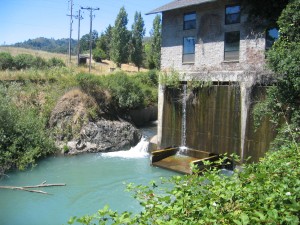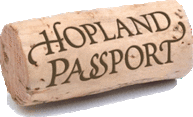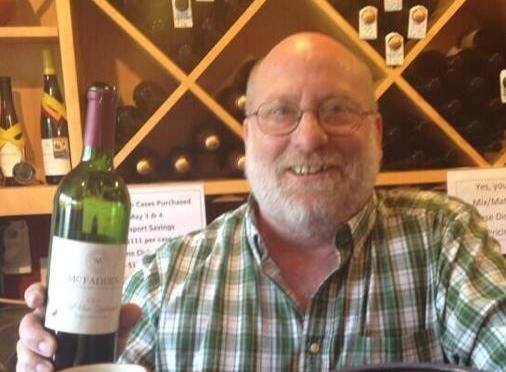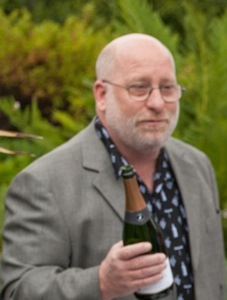
Most days, I drive to Hopland to open my tasting room for Guinness McFadden. Yesterday, I drove to the California State Capitol to see Guinness receive a Best of Show Golden Bear trophy for his sparkling brut, the best of the best at the California State Fair Commercial Wine Competition.

Each county in the state has a window box to promote their county. I saw that our county promotes Anderson Valley’s Pinot Noir Festival, a great event, but doesn’t mention Hopland Passport, inland Mendocino’s biggest wine event. It is hard to get folks outside the county to visit Hopland when the folks who do the tourism marketing do not tell folks about us.

I met Guinness McFadden and Judith Bailey inside the state capitol. The rotunda is beautiful and gold gilt is everywhere to be seen.

At 9:00 a.m., we moved into the Governor’s office.

Navarro winemaker Jim Klein called everyone he knew to say, “Guess where I am calling you from. I’m calling you from the Governor’s office.” He also protected the pastries from me.

Ted Bennett, owner of Navarro in Mendocino County’s Anderson Valley relaxes before the day’s award ceremony.

Harry Hansen of Sterling Vineyards in Napa County – the folks with the tram – converses with Guinness McFadden about grapes Sterling buys from McFadden Farm and about people they know in common. Meanwhile, Judith keeps up with social media.

California State Fair Commercial Wine competition co-Head Judge and Sacramento Bee wine writer Mike Dunne talks with Mitch – Mr. Carol Shelton.

Carol Shelton in animated conversation. I had the great pleasure and honor to work with Carol for eight years and together we won a lot of awards; Carol won a Golden State Winery of the Year bear trophy for being the top awarded winemaker at the CA State Fair, and I won three consecutive Expert exhibitor awards from Exhibitor Magazine for marketing and selling her wine. We also had a great time working together at a Meet the Winemaker Dinner at Zinfandel in Chicago. I adore Carol!

Guinness chatted with Rick Pickering, CEO of the CA State Fair.

At 9:45 a.m., we moved outside to the east steps of the Capitol. City folks stood in the sun, country folks had the sense to find shade from a tree.

Bears, lots of bears; maybe more bears that at the Russian River on a three day weekend. I see bears!

Words that should be, but likely won’t be, written by Wine Spectator and Connoisseurs’ Guide to California Wines: “The best wines in California are coming from Mendocino County.” Fully half of the Best of the Best wines were made by Mendocino County wineries; Navarro, McFadden, and Fetzer. Sterling and Carol Shelton buy Mendocino County fruit to make some of their wines too. The biggest winner of the CA State Fair Wine Competition, as I see it, is Mendocino County!

I don’t know whether I wanted to see Guinness get his bear or whether I wanted to display the bear in our tasting room more.

L-R, Navarro Best of Show Dessert, Pedroncelli Best of Show Pink, Carol Shelton Best of Show White, Sterling Best of Show Red, McFadden Best of Show Sparkling, and Fetzer Best Value.

While waiting until 10:00 a.m., Guinness and Judith chatted with Seana Doughty and Dave Dalton of Bleating Heart Cheese.

That big blue ribbon is nice, but folks came today for bear trophies. This year, there were 2,829 wine entries from 746 winery brands. Seventy-four judges on 18 panels awarded 2,068 medals, including 52 Double Gold, 217 Gold, 1,085 Silver, and 714 Bronze.

No award was ever given at the capitol without a speech, or speeches. Awards were presented by Jim Houston, deputy secretary, California Department of Food and Agriculture, Paul Martin, deputy Director, Governor’s Office of Business and Economic Development, Rick Pickering, CEO, California Exposition & State Fair, Sonney Chong, board chair, California Exposition & State Fair, and Rick Kushman and Mike Dunne, California State Fair chief wine judges. On the far left is CA Assemblyman, the Honorable Wesley Chesbro, who would make a very special presentation.

Dave Dalton and Seana Doughty of Bleating Heart Cheese in Tomales won two Golden Bear trophies. Best of Show Cow Cheese for Moolicious Blue and Best of Show other udder (sheep) for Fat Bottom Girl.

Jim and Ted received the first wine award of the day for the 2013 Navarro Vineyards Late Harvest Riesling, the 2014 California State Fair Best of Show Dessert winner.

Navarro’s 2013 Late Harvest Riesling also took a Double Gold Medal.

Navarro’s 2013 Late Harvest Riesling was rated 98 points.

The longest presentation of the day was for Guinness McFadden. Get ready for many pictures.

As Assemblyman Chesbro spoke, a framed resolution appeared, and Guinness began to suspect that he wasn’t getting only a bear.

Don’t get me wrong, a bear as recognition for producing the Best of Show Sparkling would be great, Guinness was pleased as punch to be invited to the Capitol to receive it, but at this point he is getting quite a surprise.

Guinness received a Joint Resolution from the CA Assembly and Senate in recognition of his over 40 years of organic growing and eco-friendliness.

Again, a Golden Bear trophy is going on my bar in the tasting room, but this beautiful framed resolution is going on the wall as soon as I can get Guinness to give it up.

The wine that Guinness earned his Best of Show Sparkling bear trophy with is the NV McFadden Vineyard Cuvée Brut

The NV McFadden Cuvée Brut also took a Double Gold Medal.

The NV McFadden Cuvée Brut was rated 98 points.

CALIFORNIA LEGISLATURE Assembly RESOLUTION By the Honorable Wesley Chesbro, 2nd Assembly District; and the Honorable Noreen Evans, 2nd Senatorial District; Relative to commending GUINNESS McFADDEN WHEREAS, On June 24, 2014, NV McFadden Sparkling Brut, a wine produced by McFadden Vineyard, will receive the California State Fair Best of Show Sparkling Award, and upon this occasion, the owner of McFadden Vineyard, Guinness McFadden, is deserving of special public recognition; and WHEREAS, Growing up the oldest of five children in the upper west side of New York City, New York, Guinness McFadden turned down an Ivy League scholarship in 1956 to attend the University of Notre Dame, where he received his Bachelor’s degree in History and participated on the varsity wrestling team; and WHEREAS, After graduating, Guinness enlisted with the United States Navy; serving for nine years,his notable activities during this time included serving a tour in the Mediterranean, where he developed his love for wine; captaining a river boat in Vietnam, where he learned fluent Vietnamese and earned a Bronze Star medal; and serving as an admiral’s aid in Lisbon, Portugal, where he again acquired the native tongue; and WHEREAS, After leaving the Navy, Guinness returned to the United States in 1969 and enrolled at Stanford Business School; after a brief period, he realized that his interests would be best served elsewhere, and he ultimately settled down in a Potter Valley, Mendocino County, California; and WHEREAS, McFadden Vineyard originated in Potter Valley as nothing more than two small vineyards that were each no larger than 15 acres; today, Guinness’ business encompasses some of the oldest vines of the nearly 1,500 acres of vineyards in Potter Valley, and his grapes have represented a significant portion of many award-winning wines in Napa, Sonoma, and Mendocino counties; and WHEREAS, A community leader whose unwavering dedication to organic farming has continued for over 40 years, Guinness supplemented his Eco-friendly vision of sustainable agriculture in 1983 by building a hydroelectric power plant capable of powering 100 homes, and in 2005, he installed 300 solar panels to make the farm completely energy independent; McFadden Farm now produces energy far beyond its own needs and provides enough extra to power over half of Potter Valley’s businesses and residences; and WHEREAS, The contributions Guinness McFadden has made to the welfare and improvement of the local agricultural community have been invaluable, and he has served as a worthy model for all public-spirited people of the State; now, therefore, be it RESOLVED BY ASSEMBLY MEMBER WESLEY CHESBRO AND SENATOR NOREEN EVANS, That Guinness McFadden be commended for the significant contributions he has made to the people of the local community and throughout California, and extended sincere best wishes for continued success in the future. Members Resolution No. 1464 Dated this 24th day of June, 2014 Honorable Wesley Chesbro 2nd Assembly District Honorable Noreen Evans 2nd Senatorial District

Huge thanks to Honorable Wesley Chesbro 2nd Assembly District and Honorable Noreen Evans 2nd Senatorial District, and the folks in their offices, who made this happen, and helped surprise Guinness McFadden, a man richly deserving of your kind recognition

Guinness will have a big party at McFadden Farm on Saturday, July 12 from 5:00 p.m. to 11:00 p.m. and will release his newest bubbly, a Brut Rosé. BBQ Dinner, wine, bubbly, live music, D.J., dancing, camping overnight if you wish. $60, or $50 for McFadden wine club members. For more info or tickets, visit http://www.mcfaddenfarm.com/Annual-Wine-Club-Dinner-_p_73.html

Guinness flew in for this award from Kentucky where he saw his newest grandchild for the first time, and to celebrate the third, and littlest, Guinness McFadden

Wine Spectator magazine published a list of 150 Summer Sparkling Wines, but didn’t include McFadden Brut, even though 20 of the 23 included bubblies were beat by two, not one but two, McFadden Sparkling Bruts at the 2014 San Francisco Chronicle Wine Competition. One of the 23 tied our Bruts with a Double Gold. Two bubblies beat our Bruts, taking co-Best of Sparkling awards. The other 127 bubblies didn’t compete, maybe because they already get listed in magazines instead. Did I mention that a McFadden Brut was judged Best of Show at the 2014 California State Fair Commercial Wine Competition, beating all competition? We would love to be considered by Wine Spectator magazine in the future. What’s a guy got to do, send an invite to our annual wine club dinner to the guy making the lists? Already done, still waiting for a response.

If you visit the McFadden Farm Stand & Tasting Room in Hopland, the highest rated tasting room in over five years of San Francisco Chronicle tasting room reviews, you’ll find more than highly rated, award winning wines and bubblies; McFadden has organic grass fed beef, organic air dried herbs and herb blends, and so much more seasonal goodness from organic and family owned McFadden Farm.

A man and his bear trophy, and his resolution.

Ed St. John collects his Golden Bear Trophy for the 2013 Pedroncelli Signature Selection Dry Creek Valley Dry Rosé of Zinfandel, winner of Best of Show Pink, a Double Gold, and a 98 Point Rating from the 2014 CA State Fair Wine Competition

Carol Shelton has won many awards over the years from the California State Fair, and has judged at the competition – and others – as well.

I first met Carol at Windsor Vineyards, where she made wine and I developed a successful tradeshow program. Maya’s monologue in the middle of the movie Sideways could have been inspired by Carol describing her wines to folks new to them, the passion and love are palpable, her energy infectious.

Everyone, upon hearing that Carol won a CA State Fair Best of Show award assumes it is for her Zinfandel, but are pleasantly surprised to find she is back to making white wine…huge medal white wine

There is a chance, my fingers are crossed, that Carol may make a Wild Thing White to go with her Mendocentric Wild Thing Zin (red) and Wild Thing Rosé. If things work out, it could be based on McFadden Farm Sauvignon Blanc grapes.

Best of Show White goes to the 2012 Carol Shelton Wines Coquille Blanc, a Rhone style white blend. Deservedly, it also took a Double Gold Medal and a 98 point rating at the 2014 California State Fair Commercial Wine Competition

Harry Hansen of Sterling Vineyards receiving his Golden Bear trophy.

Sterling Vineyards has made both Sauvignon Blanc and Riesling from McFadden Farm grapes.

The 2010 Sterling Vineyards Platinum Napa Valley Reserve Cabernet Sauvignon earned 98 points, a Double gold Medal, and the Best of Show Red Golden Bear trophy

Navarro Vineyards of Mendocino County was called back up the steps to receive another Golden Bear award trophy, having earned the title “Golden State Winery of the Year”

Fetzer of Hopland in Mendocino County did not show up to pick up their Golden Bear trophy for their 2011 Fetzer Valley Oaks Moscato, judged Best Value Wine at the competition, at $7.99 for a Double Gold & 98 Pointer. If Jim and Ted were to pick it up and take it to them on the way back home, they could have practiced juggling three Golden Bear trophies.

Navarro richly earned the Golden State Winery of the Year award with three, count ’em, I said three wines scoring 98 Points and taking Double Gold Medals. Congratulations to our friends from the Anderson Valley.

Mendocino County wineries earned 4 of the 7 Golden Bear Trophies awarded from the California State Fair for wine: Navarro – Golden State Winery of the Year, Navarro – Best of Show Dessert, McFadden – Best of Show Sparkling, and Fetzer – Best Value; 98 points and Double Gold, each and every one of them. When will the wine press begin to report regularly on the supreme quality of Mendocino grapes, county wide? Perhaps when our county tourism groups and grape promotion groups get the budget to market the news. The wineries are doing their part.

Jim Klein, winemaker, and Ted Bennett, owner, Navarro Vineyards, California State Fair Golden State Winery of the Year and Best of Show Dessert award recipients.

Cameras were present to record the Mendo magic in Sacramento

Jim, you described step by step how you make your Dry Rosé of Pinot Noir at this year’s Pinot Noir fest in Anderson Valley. It is amazing, and I would love Guinness to make something like your rosé from his Potter Valley grapes. My notes are woefully incomplete. Would you consider sharing again?

Seana and Dave with their dual Golden Bear trophies

Guinness McFadden reads his resolution

Ted and Jim answer questions from the collected press

Mitch and Carol enjoy their wonderful white wine win

Shelton, McFadden, St. John…Hey, where’s the Italian names?

The Golden Bear recipients from this year’s CA State Fair Wine Competition

Ted, Jim, Carol, Guinness, Ed, Seana, Dave, and Harry

Congratulations to Bleating Heart Cheese of Tomales. It’s official, you’re winners, hard or soft.

Bennett, Klein, Shelton, McFadden, St. John, Doughty, Dalton, and Hansen

Harry Hansen, Best of Show Red, Sterling Vineyards

Ted and Jim’s Excellent Adventure

Guinness McFadden, Golden Bear Trophy Winner and Joint Legislature Resolution Presentee

Bronze Star, Bear, Resolution; it’s got to be Guinness

It was nice to see Guinness moved by the presentation, and I am genuinely grateful to everyone who helped pull it together in the very limited time we had

Guinness was floored at the depth of research that went into the resolution.

No more ribbons, McFadden wants Golden Bears from now on. Okay, seriously, everyone here was humbled, honored, moved by the ceremony and incredibly thankful to everyone who made it possible































































































